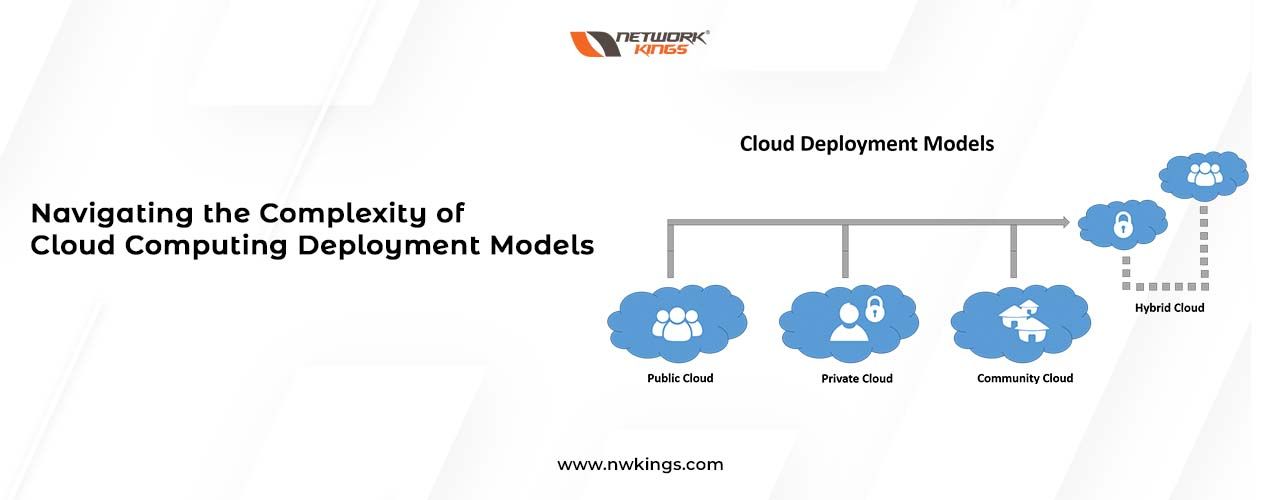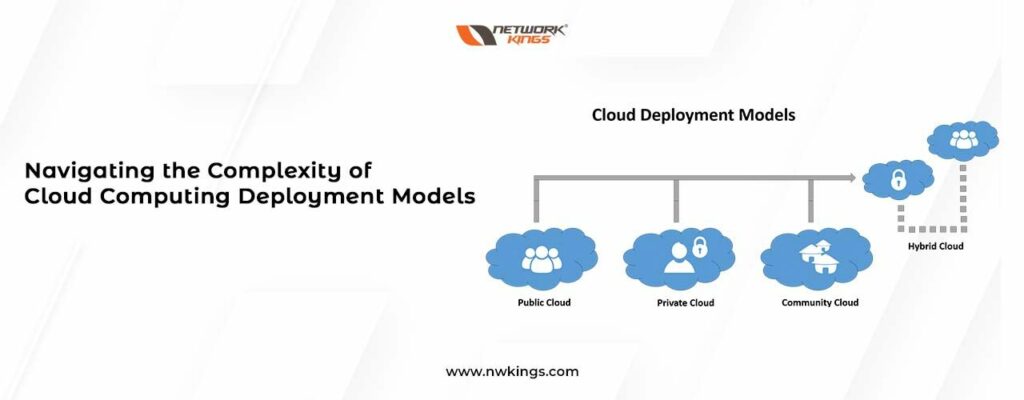
The emergence of cloud computing has been a revolution in the way we work. It provides access to advanced computing capabilities, cloud computing deployment models, and virtualisation technology, enabling organisations to deploy applications across multiple platforms at lightning speed, thus reducing operational costs and accelerating innovation.
In this blog, we will take a look at different deployment models and strategies on offer in terms of their associated architecture choices as well as cross-platform options – all presented to give organisations maximum flexibility when it comes to leveraging these powerful tools. What impact could such scalability have on your business? How can you make sure that cloud services are properly configured? These are just some questions which will be explored over time here!
Understanding the Fundamentals of Cloud Computing
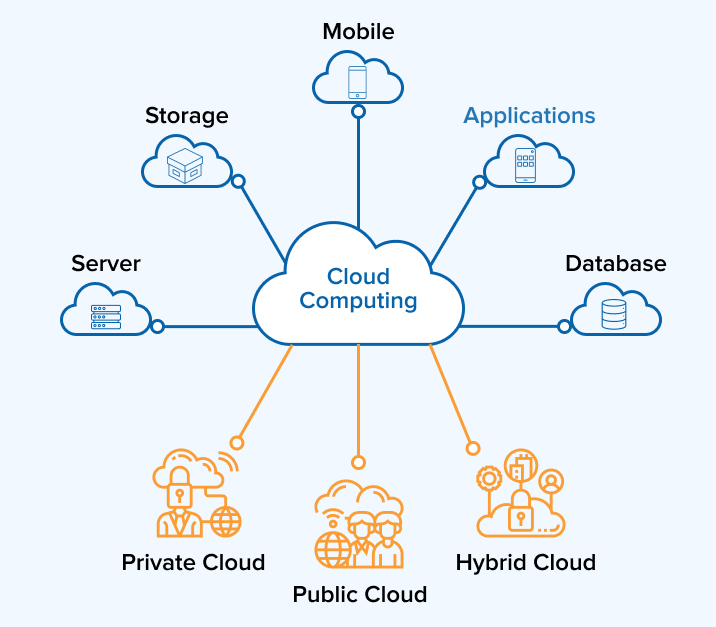
Cloud Computing has caused quite a stir in the IT world over the last decade. It has become one of the most popular ways for companies to store and process data, but what does this mean for businesses? How can they use Cloud Computing to their benefit? To figure out how best to make use of Cloud computing, it is important that we have an adequate grasp of its fundamentals. But just what are these fundamentals, and why do they matter so much when using cloud services?
When it comes to cloud computing deployment models, there are three primary choices available: Infrastructure as a Service (IaaS), Platform as a Service (PaaS) and Software as a Service (SaaS). IaaS gives organisations the ability to outsource hardware such items as servers and storage space, while PaaS provides access to application frameworks including webmail and database management systems. In addition, SAA primarily focuses on providing customers with software applications accessible via the Internet.
For businesses considering taking up cloud computing – particularly those who might be looking for flexibility or scalability – Iaas can often appear as an attractive option.
When it comes to IaaS, businesses can rent virtualised servers from a third-party provider who’ll manage all their technological needs in terms of hardware maintenance, backup services and so on. This way they can turn more focus onto their core business operations instead of managing the IT infrastructure by themselves. But when deciding which cloud computing deployment model is right – be that IaaS or any other – businesses must first think about exactly what they need before concluding which one would suit them best.
It’s essential for companies wanting to make the most of cloud computing that they get their heads around its fundamentals. Examining each deployment model – from IaaS, via PaaS and on to SaaS – can give them a greater knowledge of how utilising the cloud might best match up with what they need advantageously. For instance, if a firm just wants access to certain software applications then perhaps using SaaS is ideal because it brings savings through providing off-the-shelf solutions both in terms of time and money.
On the flip side, though, if an organisation has aspirations for more control over its technology infrastructure then maybe Iaas could be better due to increased flexibility when compared with conventional IT resources setups. What about you? Are you weighing up your options regarding which route would work out fine or are already taking strides down one path?
Exploring Varieties in Cloud Computing Deployment Models

Exploring the range of cloud models has been a major worry for both businesses and individual users who are taking into account utilising cloud computing. It is essential to know about the various types of models since each one presents diverse advantages that could influence how effective your cloud computing system is. Essentially, there are four main deployment alternatives – public, private, hybrid and multi-cloud – all with their pros and cons depending on which applications or organizations you are dealing with. What might be an optimal option for one organization may not be appropriate at all for another!
Public clouds enable organisations to get hold of storage and compute services from a third-party provider via the internet, without having to buy servers or construct their data centres. These solutions allow companies to quickly start up resources as soon as they are needed since there is no need for them not to undertake the process of obtaining physical hardware. What is more, they can scale up or down simply in response to their evolving requirements. However, public clouds may also present some security risks – users have no other option but to put trust in their provider’s infrastructure and data safety measures. Do you think that this level of trust could be justified?
Private clouds offer organisations their own dedicated storage and computing resources, tied together with a private internal network (or LAN). This gives businesses more control over how data is stored, managed, used and shared compared to public cloud solutions. Not only that – they also benefit from economies of scale as they don’t need to pay for usage costs like on the public side.
And when it comes down to security – with all data staying within an organisation’s walls while being monitored by its systems – there are often fewer risks than what would be seen in common public spaces That said; private clouds can provide peace of mind for those concerned about who has access to sensitive information or want greater assurance about the safety of their business’ digital assets.
Yet, these solutions are usually costlier and intricate as businesses have to take care of everything themselves rather than counting on a third-party supplier. Hybrid clouds present organisations’ suppleness by granting them the capacity to employ both private and public resources side by side by what seems reasonable for any given job or application at any specified phase. This allows companies to move several workloads offsite while keeping other elements nearby to uphold essential performance markers like minimum latency when accessing components situated in precise (private) positions or areas all over the world.
Hybrid cloud deployments could be better when it comes to scalability compared with purely private solutions, as users can add capacity from external sources without needing a large overhaul of their current infrastructure setup. Making use of multiple public cloud providers concurrently can work out well for customers who wish to gain from the services supplied by vendors while having less chance of vendor lock-in if service quality dips at any point down the line with one particular provider due to either cost or performance problems – likewise, this affords teams greater suppleness managing workloads across numerous public suppliers which may help lower total cost ownership (TCO).
Nevertheless, multi-cloud environments might be tougher to set up in comparison with single supplier options owing to the intricacy associated with controlling contrasts between products/services/pricing provided by various dealers plus difficulties such as data transportability among them – typically requiring skilled personnel recognizing minutiae related each platform so that implementations will perform appropriately on an extensive scale.
Detailed Review of Deployment Strategies in Cloud Computing
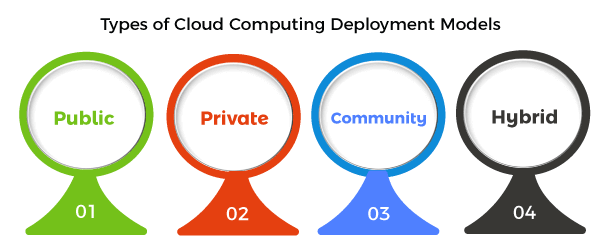
Cloud Computing is a much-used service model that more and more organisations are taking advantage of for their IT infrastructure requirements. For organisations to make the most out of it in terms of cost and performance, they need to fully understand all available cloud deployment models – this blog will provide an in-depth look into Deployment Strategies in Cloud Computing which encompasses Infrastructure as a Service (IaaS), Platform as a Service (PaaS) and Software as a Service (SaaS).
Providing organisations with access to virtualised hardware such as servers, storage devices, networks and operating systems – this is known as Infrastructure-as-a-Service (IaaS). This way businesses have an opportunity to use virtual machines for hosting web servers or databases. It’s a cost-effective option which eliminates the need to make upfront investments in either software or physical hardware components. IaaS provides administrators quick scalability opportunities according to changing business requirements without having to purchase extra pieces of technology equipment – how convenient!
Platform as a Service (PaaS) provides an environment where applications can be developed and deployed quickly. PaaS also takes on the responsibility of managing scalability, availability and maintenance so that developers don’t need to waste time worrying about those issues. For instance, when running apps on the platform – like middleware or runtime libraries – they will all be managed by the provider which allows organisations to save money usually spent on maintaining these software components themselves.
Software as a Service (SaaS) is one of today’s most popular cloud computing services out there. As its name suggests, SaaS means organisations can host their applications externally without needing any upfront investments in hardware or setting up complicated software systems; taking advantage of existing infrastructure makes it easier for them to deploy across multiple geographical locations easily with minimal effort needed too!
Comprehensive Look at Cloud Architecture
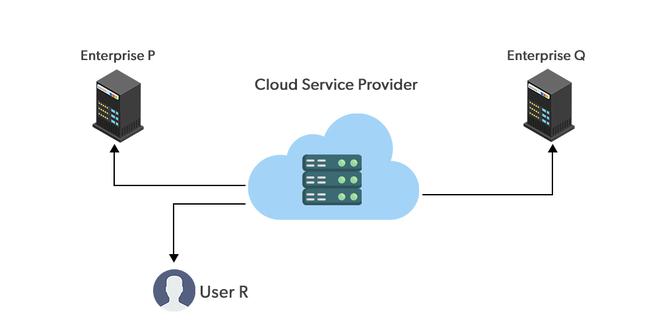
When it comes to cloud computing deployment models, there’s more than just a comprehensive look at the architecture. Cloud architecture is made up of various components and processes which make up an infrastructure; this includes hardware, virtualization technology, operating systems, data storage databases management systems networking parts and middleware elements. These are key components in any kind of cloud computing environment that can have a huge effect on performance scalability and cost-effectiveness.
To figure out what will fit best for your organization’s needs as well as budget you must be knowledgeable about each cloud’s architectonic aspects – how do they stack against one another? What impact does their use have? Having these answers can give valuable insights into using resources efficiently when it comes to using clouds!
One of the most important things to bear in mind when analysing cloud architecture is its network structure. This means exploring public networks such as the net, and private ones like exclusive fibre cables that join together different locations within an organisation. When checking out public networks you must think carefully about whether they’re fit for hosting sensitive data or safely handling high volumes of info. With private systems, there are queries concerning connection speed and cost involved. Is it worth investing extra for a dependable link or should other aspects be prioritised first?
It’s essential to be able to work out all the potential costs that come with every network option before picking which type should be adopted in a given project. When it comes to constructing any architecture, security protocols play an incredibly important role – they determine what steps must be taken so that data stored or processed through cloud servers remain protected and confidential.
Security regimes can range from two-factor authentications like using passwords along with biometrics scans to encryption technologies designed for cloud infrastructures, which are becoming increasingly popular since they provide more layers of defence than usual firewalls and other protection systems. Would you go beyond traditional firewalls?
The Role of Cloud Models in Data Storage
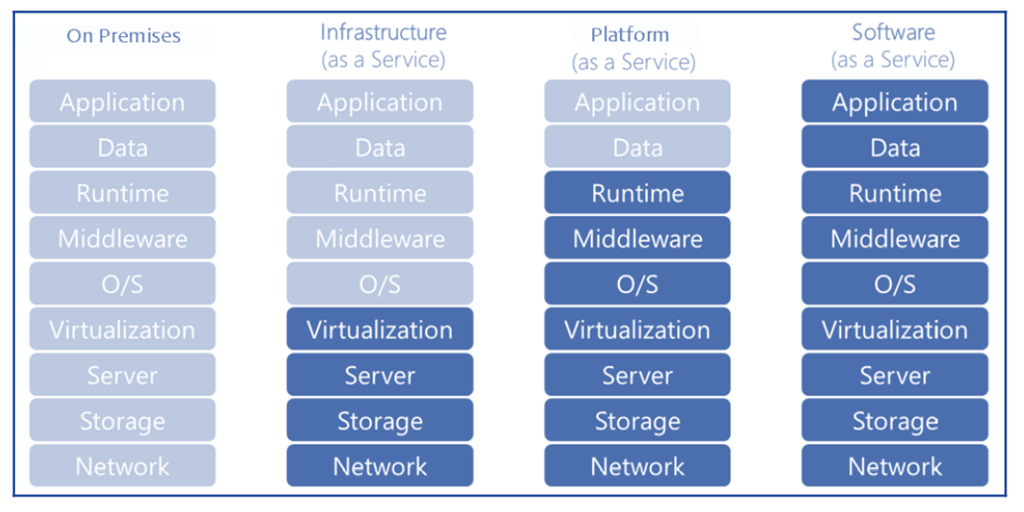
It is a fact that cloud computing has become pretty much essential for businesses nowadays. There are quite a few different deployment models for it, each with its pros and cons depending on the business needs. One of these is data storage – a vital part of every company’s operations. So let me take you through this blog post where we’ll explore the role of cloud models when storing our data and how they can help us make more use out of it!
Data storage on the cloud gives organisations a secure way of holding huge amounts of data without worrying about having enough space or access. Not only that, but it enables them to get their hands on stored information any time they want – no matter where they are in the world – just by getting online. The scalability and flexibility clouds offer ensure businesses can tailor all operations according to customers’ changing requirements as well; how cool is that?
Organisations can also benefit from using storage clouds, as it lessens the need for investing in pricey hardware, software and other resources needed for traditional storing systems such as SAN or NAS solutions. This means corporations can effortlessly expand their existing infrastructure depending on changing business demands without being concerned about overspending on additional apparatus upgrades.
Plus, they don’t have fear of regular maintenance since cloud providers take care of this automatically when told about any changes in user requirements – providing a great cost-saving solution with little effort necessary! Sounds too good to be true? Well, why not give it a try yourself and see how much you could save?
Apart from cost savings and scalability benefits, keeping data on a cloud platform also makes it simpler for organisations to comply with various regulatory laws (for example GDPR) since all uploaded information is encrypted and guarded against unauthorised access or tampering in line with industry standards. What’s more, businesses can take advantage of automated backup solutions provided by most cloud platforms so that they don’t lose important data no matter what goes wrong due to natural disasters or human errors.
In summary, taking advantage of cloud models for data storage offers many rewards for both small and large organizations including cost savings on hardware investments, scalability options according to customer requirements, tighter security measures against unauthorised access or tampering and automated backup options as assurance for preserving essential information even during unforeseen situations.
Discussing Cross-Platforms in Cloud Computing
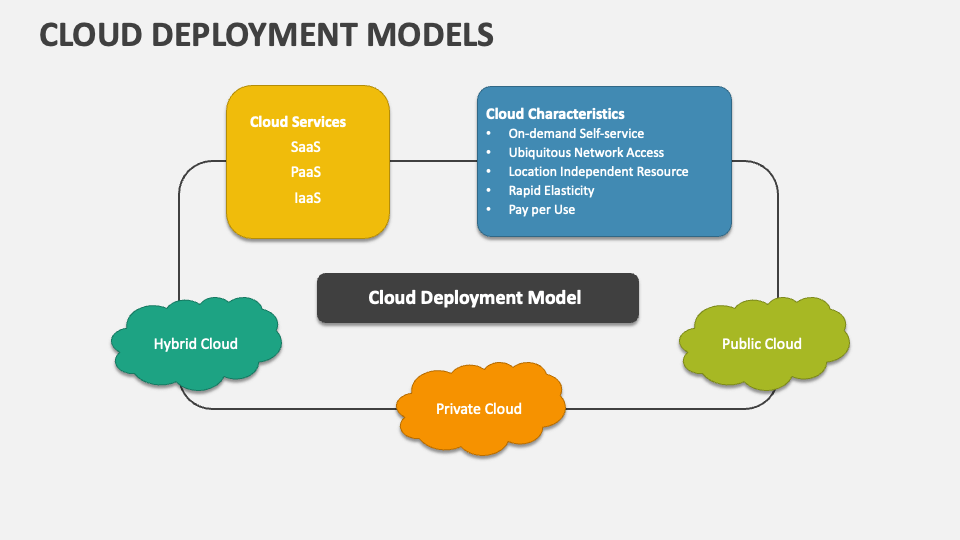
When it comes to developing a successful solution or application, being able to leverage multiple platforms no matter their origin is essential. Cloud computing deployment models have revolutionised the way developers code and store applications – from SaaS to IaaS there’s plenty of selection in this realm. One of the most crucial facets in any cloud computing set-up is its ability for cross-platform usage – let us take a look at how different operating systems can be incorporated together for maximum efficiency!
Cross-platform technologies enable developers to build web applications which can be accessed from any device with an internet connection – this includes mobiles, laptops and tablets. This cross-platform approach permits developers the chance to reduce time spent coding or dealing with bugs as they don’t need to change things depending on operating systems across devices like Windows and Android. It also makes it feasible for users utilizing different platforms to gain access to the same apps without running into compatibility troubles. Sounds useful, doesn’t it?
Cross-platform tools are an appealing choice for developers since they help create a consistent experience across both mobile apps and web applications. Not only do these platforms benefit from increased development speed, but also the convenience of having just one version which needs to be updated – quicker launch cycles as well superior customer satisfaction levels! Moreover, by utilizing a single codebase there’s no risk of coding errors or redundancies resulting from different languages being integrated into various systems; thus reducing maintenance costs and boosting overall user experience.
Cloud computing has been taking off significantly over recent years and cross-platform technology is vital in ensuring its success by making sure customers can access software regardless of what device they’re using or where it’s located. It amplifies efficacy because only one update must be handled instead multiple versions throughout varied operating systems need managing. The advantages associated with this kind of methodology are plenty: ranging from cost savings to enhanced UX – so why wouldn’t you ensure your app works perfectly on all devices?
Evaluating the Flexibility of Cloud Systems

Cloud computing is taking off as the go-to choice for entrepreneurs and tech strategists. One of its main benefits, what makes it so appealing to businesses, is that cloud systems are highly flexible – able to respond swiftly and effectively to any changes which may arise in an organisation’s IT set-up. As Cloud Computing Deployment Models become more widespread within companies, they will be well placed to benefit from these abilities – quickly aligning themselves with whatever’s going on in their industry or market at a given time.
But how do you tell if a particular system is agile enough? How can we evaluate whether one cloud platform has the malleability needed by your business? These are important questions worth considering before making such investments.
For a start, one must consider the setup of the cloud environment – this means looking at any data centres available, bodily infrastructure and services like storage or networking. Then there is scalability; can it be easily increased (or decreased)? Are there possibilities for customizing offerings so they fit businesses’ particular requirements? Last but not least what kind of backup does the cloud provider offer?
When assessing whether a certain system is capable to grow and adapt over time all those things need to be taken into account. Do you have access to enough tools within your current platform that could help with scaling up or down in future if needed? How much guidance do you think providers should give when helping customers adjust their configuration as business needs change over time?
Cloud-based applications and services have the advantage of being able to expand or contract on demand, which gives businesses a great opportunity for cost reduction without compromising their quality standards. Moreover, they are also better placed to react quickly when customers ask for something new or technology develops – automated systems mean quicker development times so updates and feature launches can be executed faster. Could that help your organisation stay ahead?
What’s more, with cloud infrastructure offering secure access from wherever there is a steady internet connection, businesses can drastically reduce their IT management needs – meaning resources can be spent elsewhere in ways that bring value back into the company. Plus as a bonus, it gives companies greater visibility on how systems are being used which could come in useful when searching for potential roadblocks or chances to increase efficacy and save money – thus preventing any unnecessary investments due to lack of data-based knowledge.
Additionally, because many API calls take place via self-service portals within the platform itself teams have wider options available than ever before when creating custom integrations between different technologies throughout an organization; this makes them much better prepared should they need to adapt quickly depending on what situation arises making them ready whatever may happen either good or bad concerning technology.
Enhancing Business Operations with Cloud Flexibility

When it comes to business growth and scalability, the performance of a business organisation relies heavily on their capability to manage cloud computing operations. Cloud flexibility is now essential for firms that want to be successful in increasing their operational agility.
The most powerful and advantageous solutions for improving business processes are focused on cloud computing deployment models. Through utilising these models, companies can refine and heighten their IT infrastructure which helps them boost product development speed, manage costs better as well and improve customer satisfaction – all key components towards kickstarting your success engine!
No doubt, private clouds offer organisations the ability to satisfy all their demands within a secure environment that’s tailored specifically for them. Moreover, one may further personalise it by adding extra services like increased storage capacity or better security if needed. On the other hand, public cloud options are perfect for firms requiring basic hosting solutions such as website hosting or domain name registration.
Alternatively, you can opt for a hybrid cloud which amalgamates features from both of these types of clouds – what many consider an ideal solution! By utilising hybrid models, businesses can reap the benefits of both kinds of cloud while maintaining control over certain areas such as data security. These deployments give organisations heightened levels of reliability and scalability which can help them reach their aims more quickly and efficiently than ever before.
A different type of deployment model is software-as-a-service (SaaS). With SaaS, could companies benefit from a host of other advantages? How would that facilitate reaching goals faster yet spending less money in the process?
Software-as-a-service (SaaS) provides organisations with a great way to access applications without having to install them on individual devices or systems. This can help make savings, as you don’t have the same costs for hardware investment and patching existing apps or installing new ones – so why not take advantage of these advantages?
However, it’s vital that when choosing a provider your organisation takes into account its own needs along with understanding all aspects involved in using SaaS services including functionality, reliability, compliance standards service level agreements etc. A wise choice by an informed business could mean getting maximum benefit from this type of technology – but more than that; will ensure peace of mind too!
Role of Cloud Models in Scalability and Adaptability

The cloud deployment model has a major impact on scalability and adaptability – two essential qualities if you want to make the most out of your cloud resources, such as software, services or infrastructure. For instance, when it comes to Infrastructure-as-a-Service (IaaS), having an easy way for you to increase the number of available resources whenever necessary is crucial for any business’s success. Moreover, being able to scale up or down depending on how much usage each component gets offers more flexibility than traditional server architectures do.
Something similar occurs with Software-as-a-Service (SaaS).
Being able to add new features and functions rapidly enables companies to meet customer expectations and respond swiftly to fluctuating market situations. Utilising cloud-based SaaS models permits organisations to upgrade their software without needing lengthy and costly development cycles for each change. Moreover, Platform-as-a-Service (PaaS) models offer scalability and flexibility advantages as well.
By exploiting PaaS versions of applications or services that are deployed in the cloud, businesses have more command over how their platforms deal with diverse circumstances or events. That includes being capable of quickly changing capacity to manage floods of traffic or activity plus providing strengthened protection methods for data kept in the cloud.
To sum up, utilising various types of cloud deployment aids enterprises to turn out even nimbler and more dynamic when it comes to operations management – after all, they can easily increase/reduce scale based on requirements meanwhile continuing top-notch delivery which satisfies users’ needs too; no wonder many companies are heading towards Cloud Computing nowadays if they want to make a name within our ever-evolving marketplace!
Future Trends in Cloud Computing Deployment Models

Cloud computing deployment models have changed the way businesses use tech to bring in innovation and efficiency. By using data stored on the cloud, firms can get real-time insights from any part of the world – enabling them to make sound decisions rapidly. That is why more companies are adopting this model for their IT needs. But what could be future trends when it comes to these deploying methods? Well, one shift that is likely soon is going hybrid with cloud deployments.
This phenomenon of combining on-premises and cloud resources to create a more comprehensive IT infrastructure is known as the hybrid model. This approach offers organisations increased flexibility and control over their data, allowing them to decide which type of cloud solution – public or private – best suits their needs. For instance, if an organisation requires better scalability or performance they may opt for a private cloud but still benefit from public services when necessary.
Moving forward it seems that multi-cloud deployments are likely to become increasingly popular too. What exactly does this mean? It’s essentially using multiple clouds at once; either simultaneously across different providers (known as cross-cloud) or in tandem with other types of solutions such as edge computing within one provider (a single ‘multi’ platform). Either way allows companies greater freedom than ever before providing even more options for optimising workloads efficiently and cost-effectively plus giving businesses unprecedented autonomy when it comes to managing these critical business technologies.
Opting for a deployment involving multiple clouds from different vendors instead of relying on one single provider is increasingly popular. This provides organisations with greater reliability and resilience, as the risk of full system failure due to issues at any individual service supplier is drastically reduced. Moreover, it gives organisations more choice when selecting providers based on price or feature requirements – they have the freedom to mix and match services according to their unique needs without being confined by just one platform vendor’s offering.
Furthermore, edge computing likely has an integral part in forthcoming cloud deployments too. Edge computing refers to placing servers close by where demands exist rather than having them located centrally as conventional data centres do; this leads not only to decreased latency but also enhanced control over data since there are fewer stops between source and destination points which ultimately promotes security levels together with improved performance levels for applications/workloads needing rapid response times (e.g.: IoT apps & AI solutions).
Wrapping Up!
To sum up: these trends allude towards increasingly advanced usage of cloud technologies boasting increased flexibility, scalability and higher levels of protection for businesses’ eagerness to utilise tech so they can gain competitive advantage.
To bring it to a close, cloud computing deployment models offer tremendous efficiency and effectiveness for businesses of all sizes. Ranging from Infrastructure as a Service (IaaS) up to Platform as a Service (PaaS), organisations can pick out the model that’s right for them to get their desired result. With its flexibility, complex design and cross-platform solutions too – companies can make alterations or extend later on if they need more space due to business growth over time. How quickly can you leverage scalable systems like this?
Are you after a career with boundless potential and amazing job satisfaction? Well, look no further than signing up to our Cloud Architect Master Program. Our program gives an extensive knowledge of cloud technologies, tools, and techniques that will enable you to be the best Cloud Architect out there. We provide expert teaching which focuses on practical learning to give you all the skills necessary for developing complex applications in the cloud environment – this is sure to show employers your capabilities!
Not only will it add something impressive to your CV but also improve employment opportunities available afterwards. On top of this, we have great connections within the industry which could help lead towards internships or even entry-level roles straight away upon finishing! So don’t put off any longer – take control of your future by enrolling on our brilliant Cloud Architect Master Program today!
Happy Learning!

